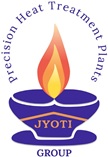Induction process heat treatment is a specialized method of heat treatment that uses electromagnetic induction to heat materials, typically metals, for hardening, tempering, annealing, or stress relieving. It is widely used in manufacturing industries because of its precision, efficiency, and ability to produce high-quality results in a localized area without affecting the entire part.
Key Features of Induction Heat Treatment:
- Localized Heating: The process heats only the area where treatment is needed, avoiding unnecessary heating of the entire part.
- Rapid Heating: Heating occurs quickly due to the high-frequency electromagnetic field, which reduces overall processing time.
- Energy Efficiency: Induction heating minimizes energy waste by focusing heat directly on the desired region.
- Repeatability: The process is easily automated, ensuring consistent and repeatable results.
- Environmentally Friendly: No direct combustion of fuel occurs, making it cleaner compared to traditional methods.
How Induction Heat Treatment Works:
- Electromagnetic Induction: An alternating current (AC) flows through a coil (the induction coil), generating a magnetic field.
- Induced Currents: When a conductive material (the workpiece) is placed inside the coil, eddy currents are induced on its surface. These currents heat the material due to electrical resistance.
- Surface Heating: The heat generated is concentrated at the surface or a shallow depth of the material, depending on the frequency of the AC and the material properties.
- Quenching: After heating, the part may be quenched (rapidly cooled) to achieve desired hardness.
Applications:
- Hardening: Commonly used for gears, shafts, and bearings to increase surface hardness while maintaining a ductile core.
- Tempering: Reduces brittleness and improves toughness after hardening.
- Annealing: Softens materials to improve machinability or relieve internal stresses.
- Brazing and Soldering: Joins metal parts with a filler material.
- Stress Relieving: Removes residual stresses in welds or machined components.
Advantages:
- High precision and control over heat-affected zones.
- Reduced distortion compared to traditional heat treatment.
- Suitable for automation, increasing productivity.
- Minimal scaling or oxidation due to localized heating.
If you would you like to know more details feel free to contact us.


